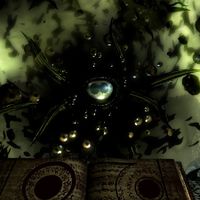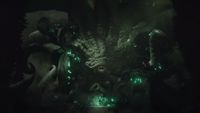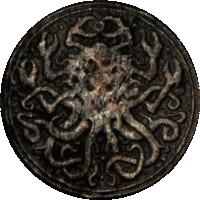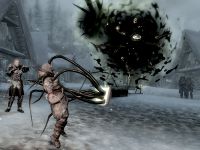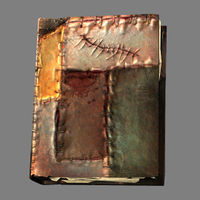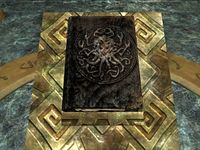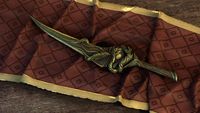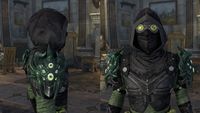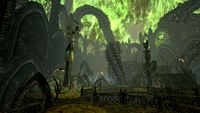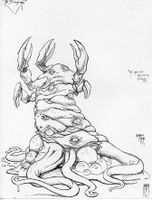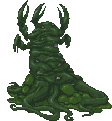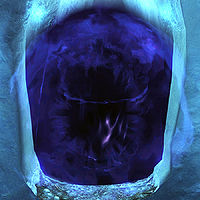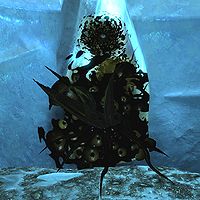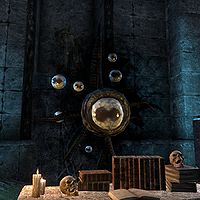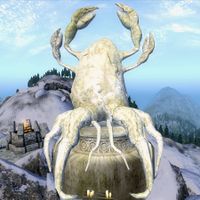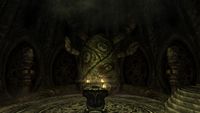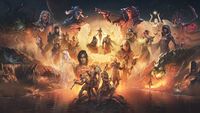Lore:Hermaeus Mora
- "I am the mystery at the end of existence. The first secret whispered at the dawn of creation. I am the guardian of the unseen and the question unanswerable. I hold the knowledge forbidden and untangle the threads of fate." —Hermaeus Mora[1]
Hermaeus Mora (sometimes spelled "Hoermius", "Hormaius", or "Herma" Mora),[2][3] the Daedra Prince of Forbidden Knowledge,[4] the Demon of Knowledge,[2] the One Who Knows,[5][1] the Master of the Tides of Fate,[6] Gardener of Men,[7][UOL 1] Prince of Fate, Lord of Secrets,[8] the Keeper of Forbidden Knowledge,[9]:293 the Golden Eye,[10][11] the Great Eye,[12] Ur-Daedra,[13] the Abyssal Cephaliarch,[14] Old Antecedent, Scryer, He Who Records All Knowledge, Inevitable Knower,[13] Lord of Fate and Knowledge,[15] also known to the ancient Atmorans and Bosmer as Herma-Mora, the Woodland Man[2][16] or "that which speaks in the wastes,"[17] to the Ayleids as Hyrma Mora,[18] and to the Khajiit as Hermorah,[19] is a Daedric Prince whose sphere is forbidden knowledge,[20] hidden shoals, whirlpools, and sudden squalls,[21] destiny,[22] and the scrying of the tides of Fate, weaving his way through the past and future as read in the stars and heavens, and in whose dominion are "the treasures of knowledge and memory".[23]:585[24] His curiosity is insatiable and he seeks all knowledge, and not to change but to observe, so that all becomes known.[8][5] He "weeps cold tears" at the plague of ignorance, where knowledge is forsaken out of fear of misuse, and seeks to enlighten all to all mysteries that have ever and will ever exist.[10] This benevolence presented by his followers may be a facade, as Mora is said to hoard his knowledge and give nothing away for free.[9][22] Like all Daedric Princes, he's not to be trifled with, but he is subtler than most of his ilk and ensnares mortals with his secrets.[22] He may seem cruel at times, but he's not irrational.[8] Mora hoards and safeguards any knowledge that could potentially endanger reality.[25]
Always lurking, he is the void and the ever-seeing eyes.[23]:585 Mora has been called the wisest of the Daedric Princes, with a mind as old as Tamriel and a body of slime,[20] though he describes himself as "the riddle unsolveable. The door unopenable. The book unreadable. The question unanswerable."[26] Unlike most Princes, Hermaeus Mora typically does not take on a humanoid form, manifesting instead as black clouds of varied, grotesque assemblages of eyes, tentacles, and claws, or a featureless purple vortex known as the Wretched Abyss,[27][28] though according to some sources he occasionally took on a form resembling that of a mortal.[UOL 2] He speaks with a thundering bray.[UOL 3]
He resides everywhere and nowhere but takes glee in tormenting mortals from his realm in Oblivion, the plane called Apocrypha, an endless library where the infinite pages of countless books containing all forbidden knowledge are found.[23]:585 Each book sports a black cover without a title, and the realm is reported to be haunted by ghosts forever searching for knowledge.[10][29] His servants include Daedra such as Seekers, Lurkers, and Watchers, but he is known to have mortal worshipers too.[30] Sailors and seafaring folk refer to Herm'us Mora as the Tide King, master of the seas and One-Whose-Tentacles-Rise-From-the-Deep,[31] a being who lurks in the oceans and pulls vessels down into the abyss.[32] Similarly, the Khajiiti Hermorah controls the tides and lives in a vast library under the sea.[19]
Hermaeus Mora is tangentially related to the origins of the Morag Tong by association with his sibling, Mephala.[2] Mora's enemies are said to be Ebonarm and Vaermina,[33][34] and his summoning day is the 5th of First Seed.[35]
Glyphics are arcane creations of Hermaeus Mora which contain pieces of knowledge or memories. With the proper enticement, they can transform into a corporeal version of the concept within.[36]
Mythology and Worship[edit]
— Bruscius Longus and Norasa Adus
Hermaeus Mora claims that he is one of the oldest Princes, born of thrown-away ideas used during the creation of mortality in the Mundus. Imperial Mananauts have verified that his influence on fate and time is real and unfeigned, implying that Mora is tied directly with Akatosh, the prime temporal spirit whose appearance led to the formation of the world, and therefore Mora may be telling the truth.[UOL 1] As some Black Books appear to have been written in the past, and others might be from the future, time appears to be more malleable for the Daedric Prince of fate and destiny.[22]
Hermaeus Mora has always tried to seduce mortals into his service with the lure of forbidden knowledge, and many scholars and loremasters find themselves ensnared forever by the lure of secrets only he possesses. Documented indications of Mora's permanent influence include incipient madness, loss of self-awareness, and black spots in the whites of the eyes.[22] Mora's knowledge reaches beyond mortal understanding but is evidently not infinite, as he still needs worshippers to dig up secrets for him.[8][UOL 4]
Ayleids[edit]
The Ayleid city of Bisnensel began to worship Hyrma Mora under the lead of High Priest Uluscant, who established a congregation in Bisnensel that attracted many of the learned and most influential people in the community. As their numbers became more numerous, on their behalf Uluscant requested more of a say in municipal affairs, a request that was denied by King Dynar. Within a few months of his rebuff, Dynar was deposed.[37] The Ayleids of Bisnensel turned the city into a shrine and stored forbidden knowledge of the natural order, which could allow one to manipulate the very fabric of reality.[38]
Bosmeri Cults[edit]
To the Bosmer, Herma-Mora is a malicious trickster spirit (one of many). Nevertheless, the Woodland Man commands a large number of devotees. However, Mora cultists in Valenwood insist that their Herma-Mora is different from the Daedric Prince Hermaeus Mora.[16] One such group was a Second Era cult, the Wooded Eye, who venerated Mora and served as guardians of the Cradle of Ilmyris—a library of secret knowledge.[39]
Dunmeri Cults[edit]
The Daedra are tied closely to the history of the Dunmer people, for good or ill. In Morrowind, Mora is known as the Golden Eye (or simply The Eye),[40] He Who Records All Knowledge, the Abider in the Abyss, Keeper of the Oghma Infinium, Master of Apocrypha, He Who Holds the Paper to the Light,[41] and the Master of the Oghma.[UOL 5] To him, knowledge and memory are the only treasures of value, gathering all words and all thoughts in the realm of Apocrypha. He has cults guarding secret libraries, such as the Devotees of Knowledge, who seek enlightenment, illumination, and a place at Mora's side.[10][11] They believe that while the Golden Eye is shunned by the crude ignorant Princes and followers of Divines alike for his wickedness, he cares little and instead watches them to document their every move. Knowledge is only as wicked as the one who wields it, and forsaking learning in fear of its misuse is an unforgivable folly that leads to mortals suffering countless centuries of loss. It is believed that pages are how Mora sees the world, so sends them out on the winds and they fill with stories. They collect information about the events around them, and when they're brought back to the book, Hermaeus learns.[10][40] When the Dagonites burned down their library and they could not salvage their books, the devotees followed the principle of knowledge gained for knowledge lost: they drained new memories from Dagon's Dremora to replace what they lost, granting their lord new knowledge on how to counter Dagon in the future.[11][UOL 5]
The Devotees believe that by dedicating ones energy, mind, and soul to Mora, he may grant them admittance into his hall of all knowledge.[40] In Apocrypha, they are permitted to browse the infinite tomes and scrolls, privy to all mysteries that have ever and will ever exist, and achieve the most blessed fate of finally sating their thirst for knowledge.[10][11]
Mora translates to "Forest" in Dark Elvish, hence he is vaguely related to the cult origins of the Morag Tong ('Foresters Guild'), if only by association with reclamation Mephala,[16] and is used in the names of many Dunmer cities such as Balmora, Sadrith Mora, and Tel Mora.[42]
Imperial[edit]
Imperial law by Uriel VII decreed that only on the official holiday of 5th First Seed should any propitiation to Hermaeus Mora be delivered, with it being stated that "All else is mutation.".[UOL 1]
Hermaeus Mora is one of the 16 acceptable blasphemes, with it being said that "HERMAEUS MORA holds the Paper to the Light."[41]
Nordic Tales[edit]
In ancient Atmora, Herma-Mora was also known as the Woodland Man (though unlike the Bosmer, the Nords acknowledge his Daedric heritage). Later research has indicated this may better translate to "that which speaks in the wastes."[17]
Most myths involving Ysgramor are about his escaping the devious schemes of Herma-Mora. He is acknowledged as a testing god.[43] Mora shares many similarities with Jhunal, which may be linked to why the latter fell out of favor in the pantheon.[UOL 6]
One fable in particular is known: Ysgramor was hunting in the Atmoran Frostwood when he sighted the White Stag of Forelgrim. After losing its trail many times, a Hare appeared, and told Ysgramor where the White Stag had gone. When Ysgramor inquired as to how the Hare knew this, it replied that it could hear it with its long ears, adding that if Ysgramor had long ears he could hear his prey wherever it went.[14]
Ysgramor idly wished his ears were as long as the Hare's; the Hare twitched its nose and Ysgramor's ears became long and pointed. Suddenly, a Fox leapt out and killed the Hare. The Fox then identified itself as Shor and the Hare as Herma-Mora, and chided Ysgramor for nearly allowing himself to be turned into an Elf. Shor then sent Ysgramor on his way, warning him to "eschew the tricks of the Elves, lest ye become one."[14]
Nords keep small statues of testing gods in their households and try to keep them appeased.[44]
Khajiit[edit]
—Fadomai, from Words of Clan Mother Ahnissi
Hermorah is known to the Khajiit as the Watcher, Spirit of the Tides,[19] and the Tide-King,[45] is the Keeper of the Knowledge of Others.[19] He was born of the second litter of Fadomai.[46] Traditionally, Hermorah records all he sees in his vast submarine library. Azurah is a frequent visitor to his domain, and Hermorah shares all he knows with her. He also helps Azurah maintain the Moons and their Motions.[19]
However, the advent of Riddle'Thar worship brought a change in thinking. Thus, more recent writings caution against Hermorah worship, describing communion with the spirit as "a fate worse than death", that will "tear a mind asunder" and "shred our sense of reality".[45]
Nede[edit]
A group of Nedes called the Seekers built a vast library called the Seeker's Archive centuries before the Yokudans came to Hammerfell. The Seekers brought gifts to the shrine of Hermaeus Mora within, and the Daedric Prince rewarded them with secret knowledge.[8] Tarish-Zi later came to the shrine for knowledge on how to create an undead army, and after building a temple atop it Mora granted him the secret of the Anka-Ra.[47]
Maormer Cults[edit]
Maormer Admiral Uhlchesis was a known cultist of Hermaeus Mora and scourge of the Eltheric Ocean. It's said that Admiral Uhlchesis' fleet raided the shores of Alinor more than a dozen times before his dark master called him to Apocrypha. They sacked enough gold for a hundred helms, though most of his ships were thought lost after their leader left Nirn.[48]
Reachfolk[edit]
Although the clans of the Reachfolk do not typically venerate or associate Hermaeus Mora with religious practices, his name is widely recognized among them, and he is closely associated with knowledge.[49] Among certain Reachfolk, he is referred to as the Woodland Man.[50] According to one account, Hermaeus Mora was reportedly unaware of certain aspects of Reachfolk practices involving the crafting of talismans to commemorate the deceased. A Reachfolk mage exchanged this knowledge for information on how to bring his deceased father, Fynboar, back to life. Despite the successful resurrection, Fynboar rebuked his son for denying the honor of his death and for defiling his rightful place in the Reachfolk afterlife.[51][52]
Sailors[edit]
Sailors know him as Herm'us Mora, whose domain is the unknowable oceans. He is the Daedric Prince of hidden shoals, whirlpools, and sudden squalls. Ships that disappear without a trace are those with captains who have angered the Tide King by challenging him, ignoring omens, or having forbidden cargo in their holds. Upon sinking, those ships end up in Fathoms Drift. Sailors are known to swear by this Daedric Prince or swear at him.[21]
History[edit]
At an unknown time, Hermaous Mora foresaw his fellow prince Ithelia unraveling reality itself due to the chaos and havoc her altering of fate caused to the fabric of fate. To prevent this outcome from happening, he gathered the other Daedric Princes, in order to remove this threat from all existence. Many of the princes agreed to assist him with this, even after showing the damage she caused to the fabric of fate. Peryite and Vaermina refused to consider the idea and opposed doing this to Ithelia. Against their wishes, he performed a spell that wiped all memories and records of Ithelia's existence and location from the minds of his fellow princes, daedra, and mortals alike. But he was unable to wipe his own memories of it, so he sealed those memories in three primordial glyphics.[53]
Merethic Era[edit]
The Skaal consider Herma-Mora to have always been their enemy, and they have many tales of Mora trying to trick them into giving up their secrets to him.[54] At some point in the Mythic Era,[23]:585 the dragon priest Miraak sought out the teachings of Hermaeus Mora, and became his champion. Mora taught Miraak the power to bend the will of dragons.[6] Another Dragon Priest, Vahlok the Jailor, uncovered this deception, and the two engaged in a duel so vicious and destructive that the modern island of Solstheim was ripped from the mainland of Skyrim.[55][56] Vahlok defeated Miraak, but just as he prepared to deliver the killing blow, Hermaeus Mora snatched away and saved his champion.[55] Though his followers were killed or scattered, and his temple razed, Miraak was able to escape into Mora's realm of Apocrypha, where he had been growing in knowledge and power over the centuries while he waited for a chance to return.[23]:585
Second Era[edit]
The Vestige is known to have transacted with Hermaeus Mora several times around 2E 582. In Craglorn, they assisted a former Star-Gazer in reaching Hermaeus Mora's shrine deep within the Seeker's Archive.[47] Hermaeus Mora offered them knowledge of the Celestials in exchange for hidden knowledge.[57] The Vestige also assisted Hermaeus Mora restore order in his temple at Rootwater Grove in exchange for knowledge of the Veiled Heritance's plans to defile the Heart of Valenwood at Hectahame.[58] The Primeval Seekers of Bisnensel petitioned the Vestige for assistance in 2E 582, but it is unclear whether they received aid or not.[59]
The Vestige also recovered the Oghma Infinium from a rebellious servant for the Prince, though Mora denied the hero access to the tome.[60][61] The Vestige also gathered three books of Dark Knowledge on the isle of Khenarthi's Roost, tomes that would steal the souls of anyone who read them. The Vestige either destroyed the tomes at Mora's Shrine or spared the books at the behest of one of Mora's followers.[62]
Later, noticing the Vestiges ties to destiny and fate, Heramous Mora would task Leramil the Wise with helping him stop this, as he foresaw the Vestige's aid as the only means she could succeed in this task, which would be to prevent the destruction of Nirn and Apocrypha.[63] The Vestige and Leramil would go to recover three glyphics known as the emerald glyphic, onyx glyphic, and umber glyphic, but they also uncovered a conspiracy amongst Mora's followers, which included a threat from vampires and a traitor in one of Mora's cults. The traitor revealed that he worked for two Daedric Princes who were involved in the conspiracy. Haermous Mora wasn't able to gleam the memories of who the Princes involved were before the vestige slew the traitor; afterwards, Hermaous Mora would enter a binding contract with the vestige using the three glythics. So long as this threat to reality was active, he wouldn't do anything to interfere with the Vestiges interests or harm the Mundus. In exchange for helping Mora save his realm and Nirn alongside it.[64]
Third Era[edit]
Around 3E 405, an agent of the Blades summoned Hermaeus Mora in the Iliac Bay region. The agent assassinated a "scrofulous patrician" who had displeased the Prince, and received the Oghma Infinium in return.[20]
The Hero of Kvatch travelled to Mora's shrine in the Jerall Mountains of Cyrodiil in 3E 433. Mora explained that his followers needed a soul from each of the ten major races of Tamriel for a divination ritual. In return for collecting these souls, the Hero was also given the Oghma Infinium.[65]
Fourth Era[edit]
In 4E 201, the Last Dragonborn encountered Hermaeus Mora in Skyrim. A quest for the College of Winterhold led the Dragonborn to Septimus Signus, a former mage of the College whose mind had suffered damage, he claimed, from reading an Elder Scroll. Signus was attempting to unlock a mysterious Dwemer lockbox which he believed held the Heart of Lorkhan. But he was unable to figure out how, and requested the Dragonborn find an Elder Scroll and record its insights into the matter using ancient Dwemer technology.[66]
The Dragonborn completed the task and returned to Septimus Signus, who then requested a sample of blood from each of the Elven races. Signus needed the samples in order to recreate the equivalent of Dwemer blood, which was the key to opening the lockbox. Additionally, the mage revealed that it was Hermaeus Mora who had led him to the lockbox, but his patron had stopped short of granting the insight to open it. Hermaeus Mora then confronted the Dragonborn directly, stating Septimus was becoming "increasingly obsolete" and offering to make the hero his champion upon fulfilling Signus' request.[66]
Ultimately, the Dragonborn returned with the Elven blood as requested, and Signus was able to open the Dwemer lockbox. However, it did not contain the Heart of Lorkhan, but a book. Before he could inspect the book, however, Signus was destroyed by Hermaeus Mora, having outlived his usefulness to the Prince. The Dragonborn retrieved the tome, and discovered it to be the Oghma Infinium. Mora then appeared one last time, granting use of the Oghma and naming the Dragonborn his new emissary (though whether or not the Dragonborn accepted this title remains unclear).[66]
It was later revealed that Miraak, the First Dragonborn, had learned his secret powers from Hermaeus Mora in exchange for a life of servitude in Apocrypha. By the time the dragons returned to Skyrim, however, Miraak had largely abandoned his master and decided to return to Tamriel by way of Solstheim. After raising an army of cultists and attempting to kill the recently revealed Last Dragonborn, Miraak bewitched much of the populace of Solstheim and forced them to build otherworldly structures around the All-Maker Stones on the island, which would be used to increase his power and provide a conduit to return to Tamriel. The Last Dragonborn tracked Miraak's activity to his temple and inside found a Black Book, an artifact of Hermaeus Mora.[30]
The Last Dragonborn destroyed Miraak's influence on the island and entered Apocrypha through the Black Books, meeting Hermaeus Mora himself. Mora told the Dragonborn that he was growing tired of using Miraak as a servant, and offered the same dragon shout he provided to Miraak in exchange for an important piece of knowledge. This knowledge was the ancient religious traditions and powers of the Skaal, who had faithfully kept it from Mora for generations.[54] The Dragonborn had to convince the spiritual leader of the Skaal, Storn Crag-Strider, to give up the knowledge, which killed him as it was removed from his body. With one end of the bargain fulfilled, the Dragonborn gained the new shout from Mora and returned to Apocrypha to face Miraak. The First Dragonborn was defeated, and Mora appeared again to express his disappointment with Miraak, and declared the Last Dragonborn to be his new champion.[30]
Artifacts[edit]
Oghma Infinium[edit]
The Oghma Infinium, also known as the Tome of Power, the Librum of Knowledge, and the Book that Knows, is an ancient tome of knowledge, and an artifact of great power. It was written by Xarxes, the scribe of Auri-El, who had been granted the knowledge within by Hermaeus Mora. The name of the tome comes from Oghma, the wife of Xarxes, whom he created from his favorite moments in history. The knowledge within the tome grants the reader access to the artifact's energy, which can be manipulated to achieve near demi-god abilities. The reader is instantly bombarded with a knowledge intake that could hemorrhage the brains of lesser mortals. The Paths of Steel, Shadow and Spirit are the three main sections of the tome. Because of the hazards it poses to its reader, this book was classified as a Tract Perilous. Once the Oghma Infinium is used, it disappears from its owner's possession.
Black Books[edit]
Black Books are Daedric artifacts created by Hermaeus Mora, the Daedric Prince of Fate and Knowledge. Each book contains some manner of forbidden knowledge. Neloth claims that no one actually knows where they came from, though the materials for their creation are prepared within a bindery in Apocrypha known as Quires Wind, before being presented to the prince to pen and complete. Some books are from the ancient past; some are from the future, as time appears to be more malleable for the Daedric Prince of fate and destiny. The thick tomes are bound in black covers, with a symbol representing Mora on the front, and emit a black mist. The books are written with Seeker ink that takes ten years to brew, on paper pressed from trees that have never seen the sun. The covers are derived from Lurker leather, and the threads used to bind the tomes together come from silk originating from the Spiral Skein. All Black Books were regarded as Tracts Perilous due to the hazards they could impose on their readers.
A number of Black Books were spread across Tamriel by Mora, and are usually located in the depths of ancient dungeons. The exact number of Black Books is unknown to everyone except for the Daedric Prince of Knowledge himself. Within every Black Book lies a forbidden secret, serving as a tantalizing temptation or reward for mortals whom Hermaeus Mora, the Great Eye, favors.
Black Books are not to be confused with the tomes of arcanists, though Hermaeus Mora himself compared their two powers, with both being knowledge he supposedly allows into Nirn. They can be compared to the Oghma Infinium, another tome of knowledge created by Mora.
Black books serve as the doorways to the Mora's realm. Through reading a Black Book, the reader will enter Apocrypha, the realm of Oblivion created and ruled over by Hermaeus Mora. Tentacles will emerge from the tome and envelop the reader. An apparition of the reader's body remains in Mundus, tethering their life force. Most mortals who read a Black Book are driven insane, but those who successfully journey through Apocrypha are known to discover powerful knowledge. Dying in Apocrypha while reading a Black Book may simply banish the reader back to Tamriel. Rereading a book will return the reader to the same area of Apocrypha, allowing them to attempt Mora's gauntlets again or harness the power of a different piece of knowledge. Copies of the contents of Black Books can be made without entering Apocrypha.
Firstblade[edit]
Firstblade, also known as Miraak's Sword, is a powerful sword linked to Apocrypha. It appears as a primal green blade with writhing sclerotic watcher tentacles and Seeker-sinew Threads wrapped around it, which extend to attack targets and drain their stamina during combat. When it is swung it takes the shape of a tentacle and grows in length, and even when not being swung, the sword writhes with tentacles around it, with them parting around the base of the sword to expose a green eye. It can be tempered with the use of ebony and daedra hearts, much like other Daedric weapons.
It is unknown if Firstblade was seen after the Merethic Era, but by the Second Era the Skaal of Solstheim knew it as a strange sword that belonged to a renegade Dragon Priest named Miraak far in the distant past. The sword was in possession of the renegade dragon priest Miraak, perhaps dating back to the time before the Dragon War, and was in his possession during his time in Apocrypha. In 4E 201, he used the sword while battling the Last Dragonborn at the summit of Apocrypha, who killed him and took possession of the blade.
Mora's Whispers[edit]
Mora's Whispers are pauldron artifacts which effect allows its user to mantle the Daedric Prince Hermaeus Mora. With its enchantment, its wearer learns faster. Knowledge literally becomes power, as the more you have accumulated, the more beneficial that it is to you. The shoulderpads are an amalgamation of the body parts of the many Daedra that inhabit Apocrypha. Skin from a Lurker provides for the armor-sheath, rune-etched tentacles from Watchers protrude the sides, living eyes are embedded throughout, and sinews taken from Seekers are sewn into it.
Other[edit]
There are a number of books connected with Mora: the Discourse Amaranthine is a "leaf" from Apocrypha that according to Mora, one will find "only delectable knowledge" within its pages,[61] though reading it causes a painful vision of Mora to appear.[67] The A Treatise on Necromantic Emanations, rumored to be penned by Hermaeus Mora himself, is a powerful artifact that must be handled with care.[UOL 5]
The Diadem of Stolen Memories is a crown granted by Mora to his Devotees. Placed upon the brow of one dead or dying, it drains memories and is used it to record the lore of the faithful, though it can also be used to take knowledge from the mind of the enemy. Once the memories are recorded, it can be thrown into a rift to Apocrypha for Mora to document.[11][UOL 5]
Apocrypha[edit]
Apocrypha is a realm of Oblivion created and ruled over by Hermaeus Mora, the Daedric Prince of Knowledge and Fate. The geography of the realm varies, with some areas being open with fields containing odd flora, other areas are an endless library consisting of untitled books with black covers, where all forbidden knowledge can be found, and the crackling towers of learning mingle with archways of despair and confusion. The realm is haunted by the ghosts of mortals forever searching for knowledge. Stacks of books form mazes and spiraling pillars that can reach as high as the illuminating green sky. Intricate ruins and monstrous carvings can be found among the stacks. The plane is covered in a sea of ink and roiling tentacles, while Hermaeus Mora is omnipresent over all, taking glee in tormenting mortals from his realm. Some areas of the realm are consumed by darkness which can kill any who enter it. Discarded pages and floating tomes fill the fetid air, as if pulled by invisible string. Storms of notorious strength purportedly rage over Apocrypha.
Apart from magical teleportation, Apocrypha is most easily entered by mortals through the reading of Black Books, tomes of forbidden knowledge displaced from time and scattered across Tamriel. An apparition of the reader's body remains in Mundus, tethering their life force. Most mortals who gain access to the secrets within Apocrypha are driven insane by unending revelations. Such was the fate of the mage Morian Zenas, who famously disappeared in Apocrypha during his voyages through Oblivion. However, those who successfully journey through Apocrypha are known to discover powerful knowledge. The laws of the mortal world hold no power in this realm.
Servants[edit]
The servants of Hermaeus Mora are described as grotesque Daedric creatures malformed by Mora who stalk the constantly elongating and retracting halls of Apocrypha, feeding off the ghosts of those seeking knowledge. Two types of Daedra—known as Keepers—dwell in this realm, maintaining the vast library and serving Mora’s mysterious will. There are Seekers, who use invisibility and mirror images as distractions while they sap strength, and Lurkers, towering monstrosities with powerful physical tendrils and poisonous bile.[23]:1065
There are other entities in the realm as well: strange floating lights called Wisp-Lanterns, writhing tentacles, and glimpses of the Daedric Prince himself.[23]:1065
Mora tasks Watchlings with observing all things and cataloguing all knowledge, so that they may act as his eyes.[5]
Knower's Eyes are another group servants of Mora, taking the form of ethereal green eyes.[68][69]
There are some Dremora in his service. One such example is Herald Kixathi, who Mora freed and taught the secret of how to sever her ties to Oblivion and bind herself to the Mundus instead. She has served him ever since, and considered him to be generous with his servants.[15]
Gallery[edit]
-
As seen in Daggerfall
-
As seen in ESO
-
Mora's statue in Oblivion
Notes[edit]
- It is thought that his name is a distant translation of a metaphor along the lines of "A Grove In The Wilderness" or "Hidden Grove," with the suggestion that he represents secret truths not easily found.[UOL 7]
- This is inspired by the concept of the "Groves of Academia" from the Latin quote Atque inter silvas academi quaerere verum from Horace's Epistles, which translates as "And Seek for Truth in the Garden of Academus."[UOL 7]
- The second part of the Prince's name, "Mora", means "Forest" or "Wood" in Aldmeris. This would explain Hermaeus Mora's nordic sobriquet as the "Woodland Man".
- Hermaeus Mora takes heavy inspiration from Lovecraftian fiction.[UOL 8]
- Ur-Mora Clarion is a region of Oblivion.[70] Its connection to Hermaeus Mora, if any, is unknown.
See Also[edit]
- For game-specific information, see the Daggerfall, Oblivion, Skyrim, and Elder Scrolls Online articles.
Books[edit]
- Apocrypha, Apocrypha — Describing the wonders of Apocrypha's trove of knowledge
- The Doors of Oblivion by Seif-ij Hidja — The chronicles of Morian Zenas' journey through the realms of Oblivion, penned by his apprentice
- Fragmentae Abyssum Hermaeus Morus — Fragmented mythical account of Ysgramor's encounter with Herma Mora, the Woodland Man
- Herma-Mora: The Woodland Man? by Reginus Buca — A scholar's theory on the etymology of Herma-Mora in Atmoran culture
- On Apocrypha — A poem surrounding Hermaeus Mora's plane of Oblivion
- Secrets Overheard in Apocrypha by Morian Zenas — Eavesdropping on servants of Hermaeus Mora
- The Worldly Spirits by Amun-dro, the Silent Priest — A pre-ri'Datta text listing deities associated with the world
References[edit]
- ^ a b Hermaeus Mora's dialogue during Eye of Fate in ESO
- ^ a b c d Varieties of Faith... — Brother Mikhael Karkuxor of the Imperial College
- ^ On Oblivion — Morian Zenas
- ^ NPC dialogue about Hermaeus Mora in Daggerfall
- ^ a b c Cres's dialogue during The Face of Change in ESO
- ^ a b Hermaeus Mora's dialogue in Dragonborn
- ^ The Gardener of Men quest in Dragonborn
- ^ a b c d e Ibrula's dialogue in ESO
- ^ a b The Elder Scrolls V: Skyrim: Prima Official Game Guide — David Hodgson
- ^ a b c d e f Apocrypha, Apocrypha
- ^ a b c d e Last Words of a Devotee
- ^ Dralys Athren's dialogue during Eye of Fate in ESO
- ^ a b Secrets Overheard in Apocrypha — Morian Zenas
- ^ a b c Fragmentae Abyssum Hermaeus Morus
- ^ a b Herald Kixathi's dialogue in ESO
- ^ a b c Varieties of Faith: The Wood Elves — Brother Mikhael Karkuxor of the Imperial College
- ^ a b Herma-Mora: The Woodland Man? — Reginus Buca
- ^ Bisnensel: Our Ancient Roots — Scholasticus Incognitus
- ^ a b c d e The Worldly Spirits — Amun-dro, the Silent Priest
- ^ a b c Events of Hermaeus Mora's quest in Daggerfall
- ^ a b The Legend of Fathoms Drift — Naeruuna, Magus of Eyevea
- ^ a b c d e Neloth's dialogue in Dragonborn
- ^ a b c d e f g The Elder Scrolls V: Skyrim Legendary Prima Official Game Guide
- ^ The Book of Daedra
- ^ Hermaeus Mora's dialogue during A Hidden Fate in ESO
- ^ Events of The Flooded Grove in ESO
- ^ Hermaeus Mora's appearance in Daggerfall
- ^ Hermaeus Mora's appearance in Skyrim
- ^ The Doors of Oblivion — Seif-ij Hidja
- ^ a b c Events of Dragonborn
- ^ Azandar's dialogue in ESO
- ^ Cap'n Dugal's Journal, Part 2 — Captain Torradan ap Dugal
- ^ Factions in Daggerfall
- ^ An Unhealthy Fate quest in ESO
- ^ Holidays in Daggerfall
- ^ Leramil the Wise's dialogue during Eye of Fate in ESO
- ^ Bisnensel: Our Ancient Roots — Scholasticus Incognitus
- ^ Herald Kixathi's dialogue in ESO
- ^ Orthenir's dialogue in ESO
- ^ a b c Lens of the Golden Eye
- ^ a b Pocket Guide to the Empire, 1st Edition: Invocation — Imperial Geographical Society, 2E 864
- ^ Sul-Matuul's dialogue in Morrowind
- ^ Varieties of Faith: The Nords — Brother Mikhael Karkuxor of the Imperial College
- ^ Nord House God item description in ESO
- ^ a b Epistle on the Spirits of Amun-dro Vol 2 — Thava-ko
- ^ Words of Clan Mother Ahnissi — Clan Mother Ahnissi
- ^ a b Events of The Seeker's Archive in ESO, and Hermaeus Mora's dialogue during the quest
- ^ Sea Elf Galleon Helm item antiquity codex in ESO
- ^ Crafting Motif 97: Wayward Guardian Style — Arana of theGhostsong Clan (as recorded by Count Verandis Ravenwatch)
- ^ Bernollach's dialogue in ESO: Necrom
- ^ Fynboar the Resurrected
- ^ Destozuno's dialogue in ESO
- ^ Hermaeus Mora's dialogue, events of Chronicle of Fate in ESO
- ^ a b Storn Crag-Strider's dialogue in Dragonborn.
- ^ a b The Guardian and the Traitor — Lucius Gallus
- ^ Tharstan's dialogue in Dragonborn.
- ^ Events of Gem of the Stars, Message Unknown and Strange Lexicon in ESO, and Hermaeus Mora's dialogue during those quests
- ^ Hermaeus Mora's dialogue during The Flooded Grove in ESO
- ^ Events of Sunken Knowledge in ESO
- ^ Events of The Waking Dreamer in ESO
- ^ a b Hermaeus Mora's dialogue during and after The Waking Dreamer
- ^ Events of Dark Knowledge in ESO
- ^ Letter from Leramil the Wise — Leramil the Wise
- ^ Events of Eye of Fate in ESO
- ^ Events of Hermaeus Moras's quest in Oblivion
- ^ a b c Events of the Discerning the Transmundane quest in Skyrim
- ^ Discourse Amaranthine memento
- ^ Knower's Eye in ESO
- ^ Quires Wind in ESO: Necrom
- ^ Lord Fa-Nuit-Hen and Tutor Riparius Answer Your Questions — Fa-Nuit-Hen andTutor Riparius
Note: The following references are considered to be unofficial sources. They are included to round off this article and may not be authoritative or conclusive.
- ^ a b c Imperial Census of Daedra Lords — the Imperial Geographic Survey
- ^ ESO Twitter Hermaeus Mora Roleplay
- ^ Mad God's Masque and Bellicose Ball
- ^ Special ZOS Lore Master Interview with Lawrence Schick
- ^ a b c d ESO Cut Content - Apocrypha's Gate dialogue
- ^ Michael Kirkbride's Posts
- ^ a b Ted Peterson Interview
- ^ Ted Peterson's Posts
|
||||||||
|
|||||||||||
|
|||||||||||
|
|||||||||||||||||||||||
|
||||||||
|
|||||||||||
|
||||||||||||||||||||||||||||||
|
||||||||||||||||||||||||||||||||
